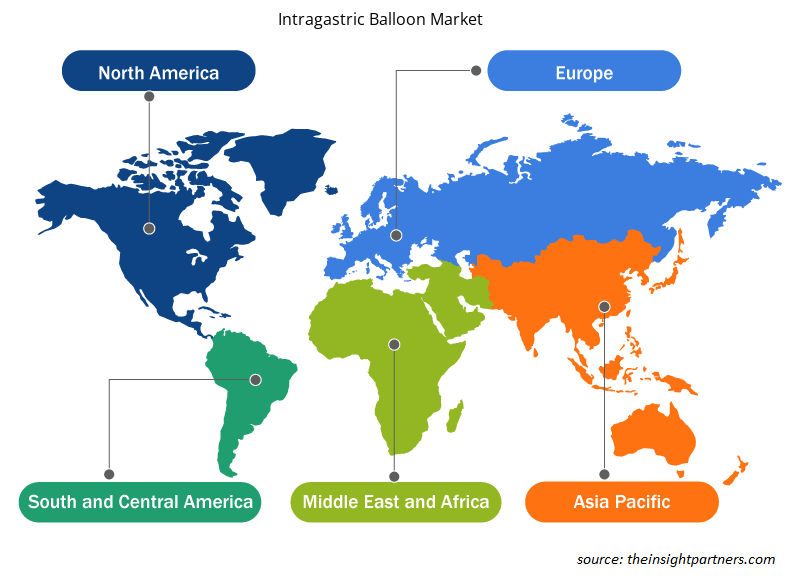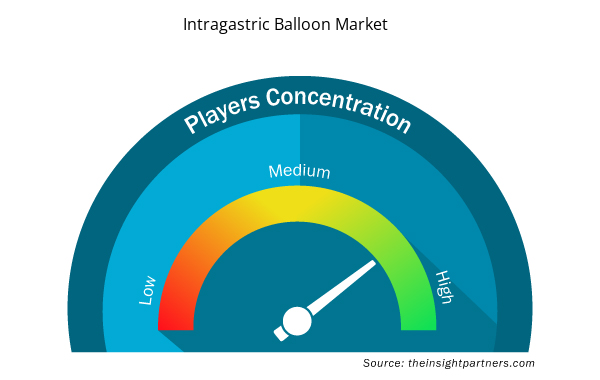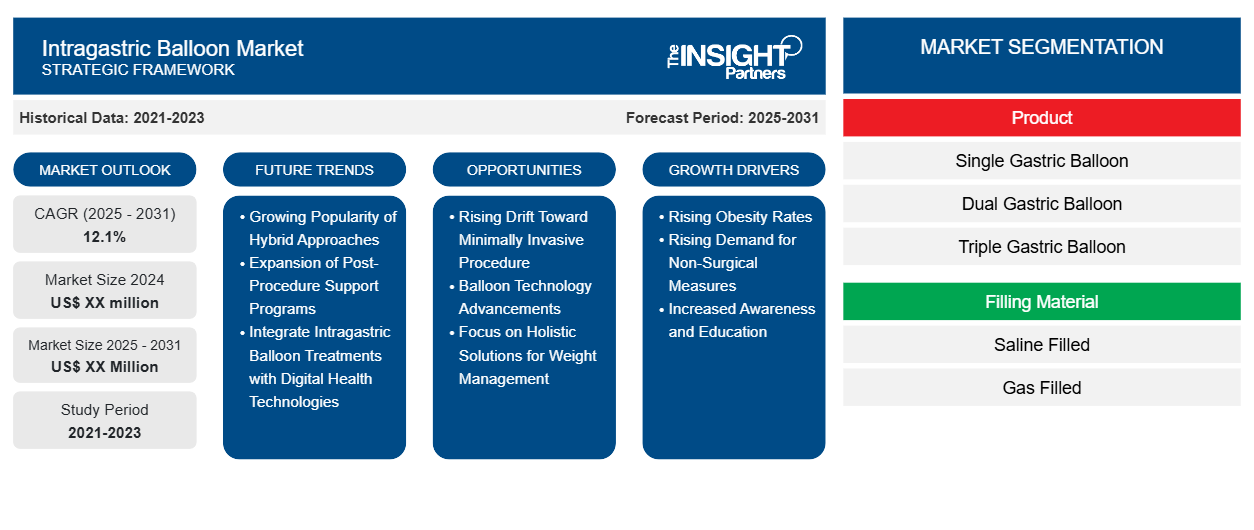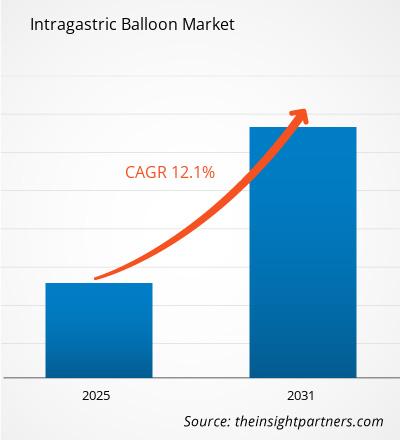胃内バルーン市場は、2023年から2031年にかけて12.1%のCAGRで成長し、市場規模は2023年のXX百万米ドルから2031年にはXX百万米ドルに拡大すると予想されています。
レポートは、製品(シングル胃バルーン、デュアル胃バルーン、トリプル胃バルーン)別にセグメント化されています。レポートではさらに、充填材(生理食塩水充填、ガス充填)に基づく分析を提示しています。さらに、エンドユーザー(病院、外来手術センター、クリニック)に基づいてセグメント化されています。グローバル分析は、地域レベルと主要国でさらに細分化されています。レポートでは、上記の分析とセグメントの値をUSDで提供しています。
報告書の目的
The Insight Partners によるレポート「胃内バルーン市場」は、現在の状況と将来の成長、主な推進要因、課題、機会を説明することを目的としています。これにより、次のようなさまざまなビジネス関係者に洞察が提供されます。
- テクノロジープロバイダー/メーカー: 進化する市場の動向を理解し、潜在的な成長機会を把握することで、情報に基づいた戦略的意思決定が可能になります。
- 投資家: 市場の成長率、市場の財務予測、バリュー チェーン全体に存在する機会に関する包括的な傾向分析を実施します。
- 規制機関: 市場の濫用を最小限に抑え、投資家の信用と信頼を維持し、市場の完全性と安定性を維持することを目的として、市場における政策と警察活動を規制します。
胃内バルーン市場のセグメンテーション
製品
- 単一胃バルーン
- デュアル胃バルーン
- トリプル胃バルーン
充填材
- 生理食塩水入り
- ガス充填
エンドユーザー
- 病院
- 外来手術センター
- クリニック
地理
- 北米
- ヨーロッパ
- アジア太平洋
- 南米と中央アメリカ
- 中東およびアフリカ
地理
- 北米
- ヨーロッパ
- アジア太平洋
- 南米と中央アメリカ
- 中東およびアフリカ
要件に合わせてレポートをカスタマイズする
このレポートの一部、国レベルの分析、Excelデータパックなど、あらゆるレポートを無料でカスタマイズできます。また、スタートアップや大学向けのお得なオファーや割引もご利用いただけます。
- このレポートの主要な市場動向を入手してください。この無料サンプルには、市場動向から見積もりや予測に至るまでのデータ分析が含まれます。
胃内バルーン市場の成長要因
- 肥満率の上昇: バルーン市場は、世界的な肥満率の急激な上昇により、大きな成長機会とみなすことができます。減量に外科手術を伴わない方法を好む人が増えているため、胃内バルーンはいわゆる非侵襲的減量法の代替品として売れるようになっています。肥満に関連する健康リスクの認識が高まるにつれて、バルーンの使用に対する需要が高まります。
- 非外科的治療の需要の高まり: 非外科的減量プログラムへの嗜好の高まりが、胃内バルーンの需要を満たしています。患者は、手術に伴うリスクを伴う治療に対してますます懐疑的になっています。バルーンの最も侵襲性の低い性質と効果的な解決策が、ほとんどの患者に高く評価されています。
- 認識と教育の向上: 体重管理の選択肢に関する医療専門家と患者の教育が進むにつれて、胃内バルーンの使用は拡大するでしょう。このような治療の利点と効率性に関する正しい教育により、患者はそれを現実的な選択肢として考えるようになり、人口のさまざまな層における市場の成長が促進されます。
胃内バルーン市場の将来動向
- ハイブリッド アプローチの人気が高まっています: 胃内バルーンと他の減量法を結び付けるハイブリッド アプローチの人気が高まっており、市場の動向が変わってきています。たとえば、ライフスタイルの変更、薬物療法、その他の最小限の介入技術を組み合わせることができます。包括的な戦略により、特により総合的で効果的なソリューションを求める患者のニーズに合わせて、体重管理のより強力なフレームワークが可能になります。
- 術後サポート プログラムの拡張: 胃内バルーン患者向けの包括的な治療サポート プログラムと統合された術後サポート プログラムの開発が進んでいます。これらのプログラムには、カウンセリング、栄養ガイドライン、フィットネス プランなどがあり、いずれも長期的な成功をもたらします。総合的なサポートに重点を置くことで、患者の良好な体験と維持が保証されます。これらは、市場での受け入れと成果の向上につながる要因です。
- 胃内バルーン治療とデジタルヘルス技術の統合: 胃内バルーン処置に使用されるデジタルヘルス技術への関心が高まっています。モバイル アプリやウェアラブル デバイスは、患者のモニタリング、食事に関するカウンセリング、医師、患者、それぞれの家族間の良好なコミュニケーションの維持によく使用されています。この傾向により、患者の関与と順守が強化され、減量の結果と処置に対する満足度が向上します。
胃内バルーン市場の機会
- 低侵襲手術への流れの高まり: ヘルスケア業界では、低侵襲手術への大きな流れが見られました。今日、回復期間が短く、合併症が少ない手術を望む患者が増えています。胃内バルーンは、この傾向に完全に適合し、侵襲手術を必要とせずに適切な体重管理を提供し、市場の可能性を高めています。
- バルーン技術の進歩: より高度な材料や設計機能を含む胃内バルーン技術の新たな開発が市場を牽引しています。これらのデバイスの耐久性、快適性、挿入の容易さが向上したことで、胃内バルーンはより効果的になり、新しい医療機器は魅力的になっています。技術の進歩により、胃内バルーンの全体的な成功率と患者満足度の向上が期待されます。
- 体重管理のための総合的なソリューションに焦点を当てる: 総合的な体重管理への関心が高まるにつれて、ライフスタイルや行動修正プログラムが胃内バルーンを補完できるため、胃内バルーンにチャンスが生まれるかもしれません。食事、心理学、身体活動のサポートによるより完全なソリューションは、患者の成果と満足度を向上させ、より大規模な減量市場において胃内バルーンをさらに魅力的な選択肢にします。
胃内バルーン市場の地域別分析
予測期間を通じて胃内バルーン市場に影響を与える地域的な傾向と要因は、Insight Partners のアナリストによって徹底的に説明されています。このセクションでは、北米、ヨーロッパ、アジア太平洋、中東、アフリカ、南米、中米にわたる胃内バルーン市場のセグメントと地理についても説明します。

- 胃内バルーン市場の地域別データを入手
胃内バルーン市場レポートの範囲
| レポート属性 | 詳細 |
|---|---|
| 2023年の市場規模 | XX百万米ドル |
| 2031年までの市場規模 | XX百万米ドル |
| 世界のCAGR(2023年~2031年) | 12.1% |
| 履歴データ | 2021-2022 |
| 予測期間 | 2024-2031 |
| 対象セグメント | 製品別
|
| 対象地域と国 | 北米
|
| 市場リーダーと主要企業プロフィール |
|
胃内バルーン市場のプレーヤー密度:ビジネスダイナミクスへの影響を理解する
胃内バルーン市場は、消費者の嗜好の変化、技術の進歩、製品の利点に対する認識の高まりなどの要因により、エンドユーザーの需要が高まり、急速に成長しています。需要が高まるにつれて、企業は提供を拡大し、消費者のニーズを満たすために革新し、新たなトレンドを活用し、市場の成長をさらに促進しています。
市場プレーヤー密度とは、特定の市場または業界内で活動している企業または会社の分布を指します。これは、特定の市場スペースに、その規模または総市場価値と比較して、どれだけの競合相手 (市場プレーヤー) が存在するかを示します。
胃内バルーン市場で事業を展開している主要企業は次のとおりです。
- アポロ・エンドサージェリー社
- リシェイプメディカル株式会社
- ヘリオスコープSA、
- アルリオンテクノロジーズ株式会社
- スパッツFgia株式会社
免責事項:上記の企業は、特定の順序でランク付けされていません。

- 胃内バルーン市場のトップキープレーヤーの概要を入手
主なセールスポイント
- 包括的なカバレッジ: レポートでは、胃内バルーン市場の製品、サービス、タイプ、エンドユーザーの分析を包括的にカバーし、全体的な展望を提供します。
- 専門家による分析: レポートは、業界の専門家とアナリストの深い理解に基づいてまとめられています。
- 最新情報: このレポートは、最新の情報とデータの傾向を網羅しているため、ビジネスの関連性を保証します。
- カスタマイズ オプション: このレポートは、特定のクライアント要件に対応し、ビジネス戦略に適切に適合するようにカスタマイズできます。
したがって、胃内バルーン市場に関する調査レポートは、業界のシナリオと成長の見通しを解読し理解する道の先導役となることができます。いくつかの正当な懸念があるかもしれませんが、このレポートの全体的な利点は欠点を上回る傾向があります。
- 過去2年間の分析、基準年、CAGRによる予測(7年間)
- PEST分析とSWOT分析
- 市場規模価値/数量 - 世界、地域、国
- 業界と競争環境
- Excel データセット



Report Coverage
Revenue forecast, Company Analysis, Industry landscape, Growth factors, and Trends

Segment Covered
This text is related
to segments covered.

Regional Scope
North America, Europe, Asia Pacific, Middle East & Africa, South & Central America

Country Scope
This text is related
to country scope.
よくある質問
The rising obesity rates and rising demand for non-surgical measures are the major factors boosting the intragastric balloon market growth.
North America region accounts for highest revenue share in intragastric balloon market.
Asia Pacific is estimated to grow at the highest CAGR over the forecast period (2023 - 2031).
The intragastric balloon market is expected to grow at a CAGR of 12.1%.
The final report will duly include market size and projection estimates for all the segments from 2021 to 2031, along with a revenue share and compound annual growth rate (%) for the regional/country-wise market wherein 2021-2022 are the historic years, 2023 is considered to be the base year, and the forecast will be provided till 2031, along with CAGR (%).
Apollo Endosurgery Inc., Reshape Medical Inc, and Obalon Therapeutics are the major companies operating in the intragastric balloon market.
Trends and growth analysis reports related to Life Sciences : READ MORE..
1. Apollo Endosurgery, Inc.,
2. Reshape Medical Inc.,
3. Hélioscopie SA,
4. Allurion Technologies Inc.,
5. Spatz Fgia Inc.,
6. Silimed,
7. Obalon Therapeutics,
8. Medsil,
9. Baronova, Inc.
10. Endalis.
11. Lexel Medical
12. Districlass Medical
13. Tulip Medical.
14. Life Partners Europe
15. Medicone
The Insight Partners performs research in 4 major stages: Data Collection & Secondary Research, Primary Research, Data Analysis and Data Triangulation & Final Review.
- Data Collection and Secondary Research:
As a market research and consulting firm operating from a decade, we have published and advised several client across the globe. First step for any study will start with an assessment of currently available data and insights from existing reports. Further, historical and current market information is collected from Investor Presentations, Annual Reports, SEC Filings, etc., and other information related to company’s performance and market positioning are gathered from Paid Databases (Factiva, Hoovers, and Reuters) and various other publications available in public domain.
Several associations trade associates, technical forums, institutes, societies and organization are accessed to gain technical as well as market related insights through their publications such as research papers, blogs and press releases related to the studies are referred to get cues about the market. Further, white papers, journals, magazines, and other news articles published in last 3 years are scrutinized and analyzed to understand the current market trends.
- Primary Research:
The primarily interview analysis comprise of data obtained from industry participants interview and answers to survey questions gathered by in-house primary team.
For primary research, interviews are conducted with industry experts/CEOs/Marketing Managers/VPs/Subject Matter Experts from both demand and supply side to get a 360-degree view of the market. The primary team conducts several interviews based on the complexity of the markets to understand the various market trends and dynamics which makes research more credible and precise.
A typical research interview fulfils the following functions:
- Provides first-hand information on the market size, market trends, growth trends, competitive landscape, and outlook
- Validates and strengthens in-house secondary research findings
- Develops the analysis team’s expertise and market understanding
Primary research involves email interactions and telephone interviews for each market, category, segment, and sub-segment across geographies. The participants who typically take part in such a process include, but are not limited to:
- Industry participants: VPs, business development managers, market intelligence managers and national sales managers
- Outside experts: Valuation experts, research analysts and key opinion leaders specializing in the electronics and semiconductor industry.
Below is the breakup of our primary respondents by company, designation, and region:

Once we receive the confirmation from primary research sources or primary respondents, we finalize the base year market estimation and forecast the data as per the macroeconomic and microeconomic factors assessed during data collection.
- Data Analysis:
Once data is validated through both secondary as well as primary respondents, we finalize the market estimations by hypothesis formulation and factor analysis at regional and country level.
- Macro-Economic Factor Analysis:
We analyse macroeconomic indicators such the gross domestic product (GDP), increase in the demand for goods and services across industries, technological advancement, regional economic growth, governmental policies, the influence of COVID-19, PEST analysis, and other aspects. This analysis aids in setting benchmarks for various nations/regions and approximating market splits. Additionally, the general trend of the aforementioned components aid in determining the market's development possibilities.
- Country Level Data:
Various factors that are especially aligned to the country are taken into account to determine the market size for a certain area and country, including the presence of vendors, such as headquarters and offices, the country's GDP, demand patterns, and industry growth. To comprehend the market dynamics for the nation, a number of growth variables, inhibitors, application areas, and current market trends are researched. The aforementioned elements aid in determining the country's overall market's growth potential.
- Company Profile:
The “Table of Contents” is formulated by listing and analyzing more than 25 - 30 companies operating in the market ecosystem across geographies. However, we profile only 10 companies as a standard practice in our syndicate reports. These 10 companies comprise leading, emerging, and regional players. Nonetheless, our analysis is not restricted to the 10 listed companies, we also analyze other companies present in the market to develop a holistic view and understand the prevailing trends. The “Company Profiles” section in the report covers key facts, business description, products & services, financial information, SWOT analysis, and key developments. The financial information presented is extracted from the annual reports and official documents of the publicly listed companies. Upon collecting the information for the sections of respective companies, we verify them via various primary sources and then compile the data in respective company profiles. The company level information helps us in deriving the base number as well as in forecasting the market size.
- Developing Base Number:
Aggregation of sales statistics (2020-2022) and macro-economic factor, and other secondary and primary research insights are utilized to arrive at base number and related market shares for 2022. The data gaps are identified in this step and relevant market data is analyzed, collected from paid primary interviews or databases. On finalizing the base year market size, forecasts are developed on the basis of macro-economic, industry and market growth factors and company level analysis.
- Data Triangulation and Final Review:
The market findings and base year market size calculations are validated from supply as well as demand side. Demand side validations are based on macro-economic factor analysis and benchmarks for respective regions and countries. In case of supply side validations, revenues of major companies are estimated (in case not available) based on industry benchmark, approximate number of employees, product portfolio, and primary interviews revenues are gathered. Further revenue from target product/service segment is assessed to avoid overshooting of market statistics. In case of heavy deviations between supply and demand side values, all thes steps are repeated to achieve synchronization.
We follow an iterative model, wherein we share our research findings with Subject Matter Experts (SME’s) and Key Opinion Leaders (KOLs) until consensus view of the market is not formulated – this model negates any drastic deviation in the opinions of experts. Only validated and universally acceptable research findings are quoted in our reports.
We have important check points that we use to validate our research findings – which we call – data triangulation, where we validate the information, we generate from secondary sources with primary interviews and then we re-validate with our internal data bases and Subject matter experts. This comprehensive model enables us to deliver high quality, reliable data in shortest possible time.


 このレポートの無料サンプルを入手する
このレポートの無料サンプルを入手する